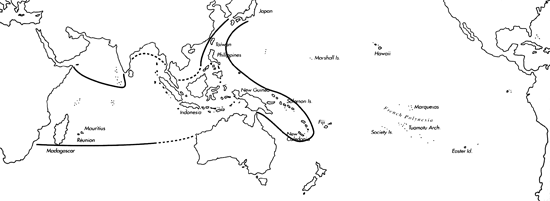
Skip Navigation Links
View access keys for this site.

Range: Japan to Philippines and Melanesia (Papua New Guinea, Solomon Islands, New Caledonia, Vanuatu); Madagascar, Reunion, Somalia, India and W. Thailand; W. Australia; probably also in Indonesia.
Description: Moderately small to moderately large, moderately light to moderately solid; relative weight may vary by 40%. Last whorl conical to ventricosely conical or pyriform, sometimes to broadly and ventricosely conical; outline convex adapically, slightly convex to concave below. Shoulder carinate, with a moderately deep to deep exhalent notch. Spire high, stepped; outline straight to concave. Larval shell of about 2 whorls, maximum diameter 0.6-0.8 mm. First 4-5 postnuclear whorls weakly tuberculate; late whorls carinate. Teleoconch sutural ramps slightly concave, with 0-1 increasing to 5-12 spiral grooves. Last whorl with punctate or axially striate spiral grooves of equal or variable width separated by strong to weak ribbons.
| Shell Morphometry | ||
|---|---|---|
| L | 33-63 mm | |
| RW | 0.06-0.25 g/mm | |
| (L 34-54 mm) | ||
| RD | 0.54-0.75 | |
| PMD | 0.82-0.92 | |
| RSH | 0.24-0.38 | |
Ground colour white or pale brown. Last whorl with spiral rows of yellowish to dark brown dots and bars on ribbons, and fusing into 3 spiral bands, below shoulder and on both sides of centre. Larval whorls white. Postnuclear sutural ramps with sparse to many brown radial markings. Aperture white.
Periostracum yellowish grey, thin, translucent, smooth.
Sole of foot white; siphon white ventro-laterally, brown dorsally (Strait of Malacca; Kohn, unpubl. observ.). Shallow water form from E. New Britain with very small brown foot (Richards, pers. comm., 1989).
Radular teeth stout, with a small adapical barb opposite a weak blade; a short serration of 7-8 strong denticles adapically, proximal denticles very strong; base with a prominent spur (Rolán, in press).
Habitat and Habits: In 10-250 m. In Papua New Guinea, a coarsely sculptured typical form on muddy bottom in about 12 m or at depths of 30-40 m (Richards, pers. comm., 1989). A W. Australian specimen has been "taken by prawn trawler in 165 metres" (Turnbull 1975; 1987, pers. comm.).; in Loyalty Is., down to 200-250 m (Richard, pers. comm., 1991).
Discussion: C. acutangulus is the most similar species. For the distinctions, see the Discussion of that species. C. praecellens varies very widely in relative diameter of the last whorl, but the variation is continuous and is not correlated with other character differences. Shells from deep water may have a slender and weakly sculptured last whorl, maculated with light brown. The type specimen of C. sowerbii is a typical specimen of C. praecellens. The taxonomic status of C. bicolor / C. sinensis remains disputable, because the type specimen is lost and the type figure (Pl. 54, Fig. 3) does not match C. praecellens in a satisfying way: The pictured shell has a comparatively low spire (RSH about 0.25), is somewhat bulbous below the shoulder, and its colour pattern consists of brown axial flammes. Coomans et al. (1982) thus consider it to represent a valid species. We favour synonymy with C. praecellens, because such pyriform specimens occur within the populations of the latter species; moreover, axial flecks are also observed in typical C. praecellens (see also Kohn, 1992). C. s. var. subaequalis (Pl. 54, Fig. 2) refers to a small individual of C. praecellens. Cernohorsky (1965) documented C. praecellens as the earliest available name for this species. Morphologically very similar specimens that differ in a multispiral larval shell (about 3 whorls) are only provisionally attached to this species.

C. praecellens range map
This section contains verbatim reproductions of the accounts of 316 species of Conus from the Indo-Pacific region, from Manual of the Living Conidae, by Röckel, Korn and Kohn (1995). They are reproduced with the kind permission of the present publisher, Conchbooks.
All plates and figures referred to in the text are also in Röckel, Korn & Kohn, 1995. Manual of the Living Conidae Vol. 1: Indo-Pacific Region.
The range maps have been modified so that each species account has it own map, rather than one map that showed the ranges of several species in the original work. This was necessary because each species account is on a separate page on the website and not confined to the order of accounts in the book.
Return to framed version (returns to search page)